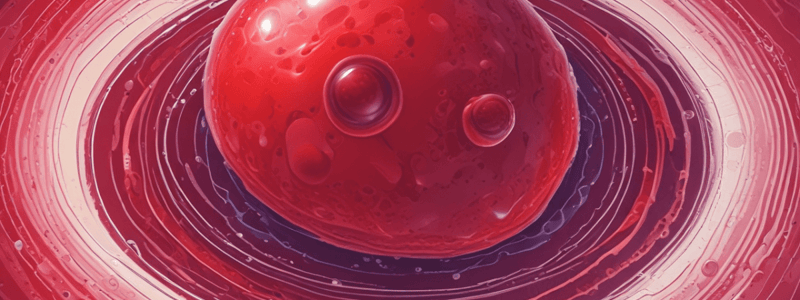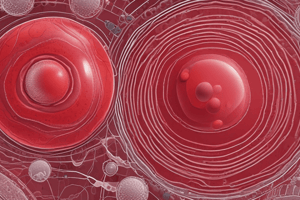Podcast
Questions and Answers
What is the primary function of the erythrocyte?
What is the primary function of the erythrocyte?
- To undergo oxidative phosphorylation
- To reproduce and divide into new cells
- To transport oxygen to tissues (correct)
- To produce stem cells in the bone marrow
What is the average lifespan of a red blood cell in adults?
What is the average lifespan of a red blood cell in adults?
- 180 days
- 60 days
- 120 days (correct)
- 90 days
What is the primary factor that governs erythropoiesis?
What is the primary factor that governs erythropoiesis?
- Kidney function
- Oxygen content of blood
- Hemoglobin levels
- Tissue oxygen needs (correct)
What is the hormone produced by the kidneys in response to decreased oxygen content?
What is the hormone produced by the kidneys in response to decreased oxygen content?
In which part of the body does red cell production primarily take place beyond 20 years of age?
In which part of the body does red cell production primarily take place beyond 20 years of age?
What is the term for the production of red cells?
What is the term for the production of red cells?
What is the iron-containing substance in hemoglobin?
What is the iron-containing substance in hemoglobin?
How many hemoglobin molecules are present in each RBC?
How many hemoglobin molecules are present in each RBC?
What is the characteristic of a mature red blood cell?
What is the characteristic of a mature red blood cell?
What is the pair of chains in fetal hemoglobin?
What is the pair of chains in fetal hemoglobin?
What is the stage of development of red cells that enter the blood?
What is the stage of development of red cells that enter the blood?
What is the reason for the biconcave disk shape of the red blood cell?
What is the reason for the biconcave disk shape of the red blood cell?
What is the result of alterations in genes on hemoglobin?
What is the result of alterations in genes on hemoglobin?
What is the primary function of erythropoietin?
What is the primary function of erythropoietin?
What is the approximate age at which fetal hgb converts to adult hgb?
What is the approximate age at which fetal hgb converts to adult hgb?
What is the function of the iron atom in the heme unit of hemoglobin?
What is the function of the iron atom in the heme unit of hemoglobin?
What is a potential consequence of genetic mutations affecting hemoglobin protein formation?
What is a potential consequence of genetic mutations affecting hemoglobin protein formation?
What is necessary for red blood cell survival?
What is necessary for red blood cell survival?
What happens to the hemoglobin released into the circulation when a red blood cell disintegrates at the end of its lifespan?
What happens to the hemoglobin released into the circulation when a red blood cell disintegrates at the end of its lifespan?
What is the fate of the iron and globin components of hemoglobin after it is broken down?
What is the fate of the iron and globin components of hemoglobin after it is broken down?
What is the final product of hemoglobin breakdown that is excreted in the stool?
What is the final product of hemoglobin breakdown that is excreted in the stool?
What is the normal rate of destruction of red blood cells per day?
What is the normal rate of destruction of red blood cells per day?
What is the normal range of reticulocytes in relation to total RBCs?
What is the normal range of reticulocytes in relation to total RBCs?
What is the normal range of hematocrit for men?
What is the normal range of hematocrit for men?
What is the suffix that refers to the size of red blood cells?
What is the suffix that refers to the size of red blood cells?
What is the normal range of hemoglobin in grams per 100ml of blood for women?
What is the normal range of hemoglobin in grams per 100ml of blood for women?
What is the term that describes the percentage of blood that is taken up by red blood cells?
What is the term that describes the percentage of blood that is taken up by red blood cells?
What is the normal range of red blood cells in millions?
What is the normal range of red blood cells in millions?
What is the normal range of Mean Corpuscular Volume (MCV)?
What is the normal range of Mean Corpuscular Volume (MCV)?
What is the normal range of Mean Corpuscular Hemoglobin Concentration (MCHC)?
What is the normal range of Mean Corpuscular Hemoglobin Concentration (MCHC)?
What is the maximum concentration of hemoglobin in a red blood cell?
What is the maximum concentration of hemoglobin in a red blood cell?
What is anemia?
What is anemia?
What is the definition of anemia in men according to the World Health Organization (WHO)?
What is the definition of anemia in men according to the World Health Organization (WHO)?
What is the term for the production of red cells?
What is the term for the production of red cells?
What can cause anemia?
What can cause anemia?
What is the term for red blood cells that are too small in size?
What is the term for red blood cells that are too small in size?
What is the term for red blood cells with too little hemoglobin?
What is the term for red blood cells with too little hemoglobin?
Flashcards are hidden until you start studying
Study Notes
Red Blood Cells (RBC)
- Mature RBCs, or erythrocytes, are non-nucleated, biconcave disks, lacking mitochondria and ribosomes.
- RBCs have a lifespan of approximately 120 days in adults and 90 days in infants; can be as short as 2-10 days in hemolytic anemias (e.g., sickle cell disease).
- The biconcave shape increases surface area for oxygen diffusion and allows flexibility without membrane rupture.
Erythropoiesis
- Erythropoiesis is the process of red blood cell production.
- All RBCs are produced in red bone marrow at birth, with production shifting to selective bones after age 5, and to vertebra, sternum, ribs, and pelvis by age 20.
- RBC precursors, erythroblasts, develop from stem cells, reducing in size as they mature; they accumulate hemoglobin and lose their nucleus.
- Red cells initially enter the bloodstream as reticulocytes and mature into erythrocytes.
- Fetal hemoglobin transitions to adult hemoglobin around 4-6 months of age.
- Hemoglobin consists of four polypeptide chains associated with heme units that bind oxygen; each molecule can carry four oxygen molecules.
Genetic Mutations
- Genetic variations can lead to abnormal hemoglobin formation (e.g., sickle cell disease) or inadequate synthesis of alpha or beta chains (e.g., thalassemia), contributing to anemia.
Factors Affecting RBC Survival
- Survival relies on intact bone marrow responsive to erythropoietin.
- Functional erythropoietin from kidneys is essential.
- Sufficient DNA components (folic acid, vitamin B12) are necessary for RBC integrity.
- Adequate hemoglobin synthesis depends on iron and globin availability.
RBC Destruction
- At the end of their lifespan, RBCs disintegrate, releasing hemoglobin, which is broken down in the liver and spleen.
- Hemoglobin decomposes into iron and globin, which are reused, while bilirubin is formed and excreted in bile or urine.
- Typical destruction and production rates balance at about 1% of RBCs per day.
Laboratory Evaluation
- Normal RBC count ranges from 4.2-5.4 million cells per microliter.
- Reticulocyte levels indicate production rates, with a normal rate of approximately 1-2% of total RBCs.
- Hemoglobin levels vary: 13.5-17.5 g/dL for men and 12-16 g/dL for women.
- Hematocrit measures the volume percentage of blood occupied by RBCs, generally between 36-50%.
Red Cell Indices
- Used for diagnosing types of anemia based on cell size and hemoglobin content.
- "Cytic" refers to cell size, while "chromic" addresses hemoglobin concentration.
- Mean Corpuscular Volume (MCV) identifies cell size; ranges: normocytic (87-103 fL), microcytic (less than 80 fL).
- Mean Corpuscular Hemoglobin Concentration (MCHC) indicates hemoglobin concentration; normal range is 31-35 g/dL.
Anemia Definition
- Anemia reflects an underlying disease or body function alteration resulting in insufficient RBCs or hemoglobin.
- Causes include excessive blood loss, hemolytic disorders causing increased destruction, or impaired production due to deficiencies (e.g., iron, B12, folate).
- WHO defines anemia thresholds: hemoglobin < 13.0 g/dL or hematocrit < 42% for men; hemoglobin < 12.0 g/dL for women.
Studying That Suits You
Use AI to generate personalized quizzes and flashcards to suit your learning preferences.




